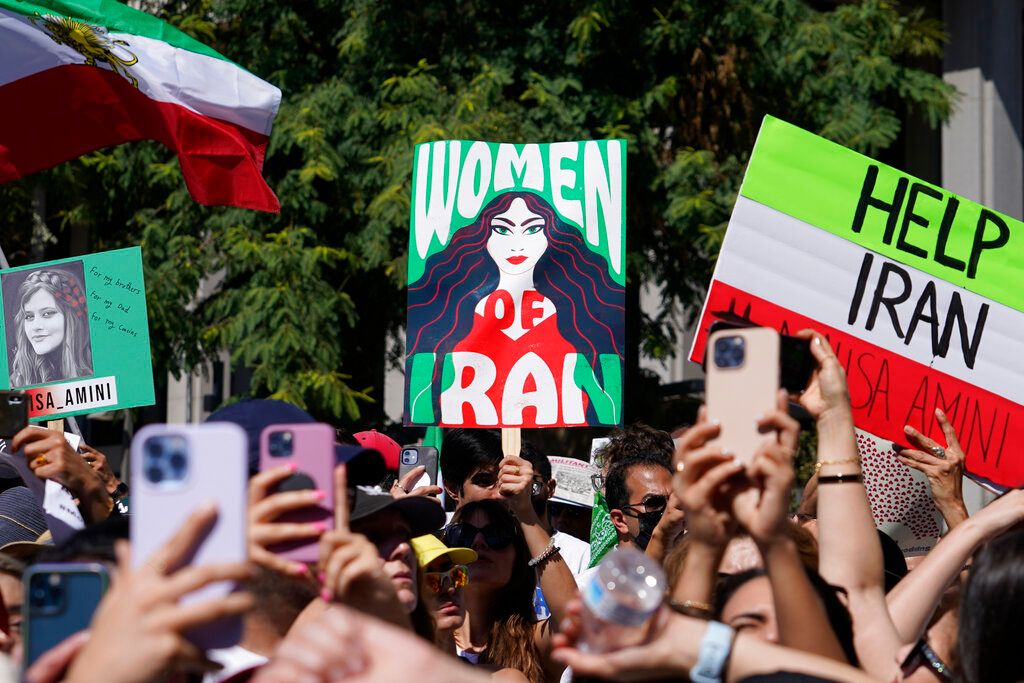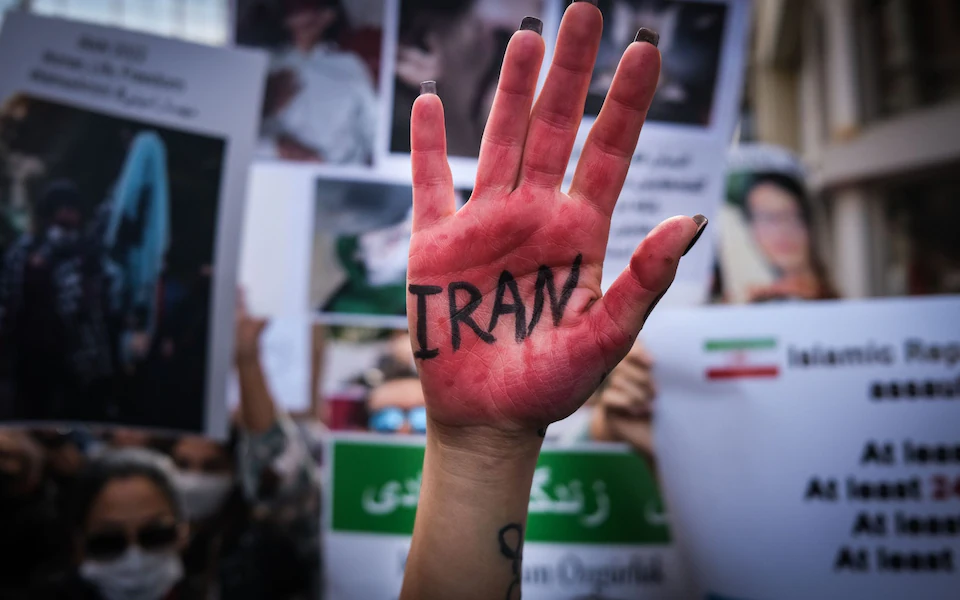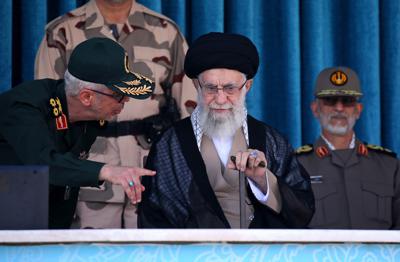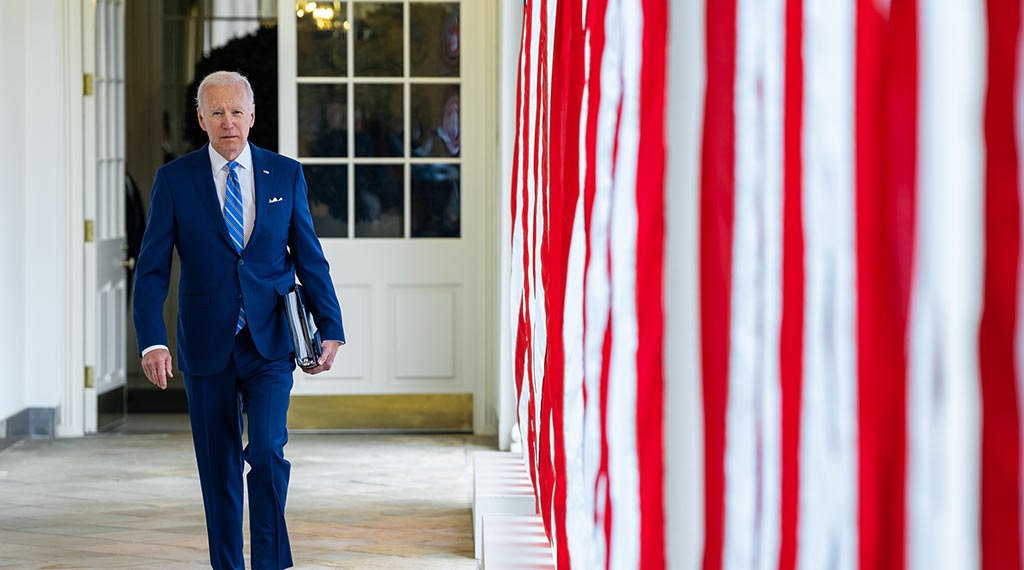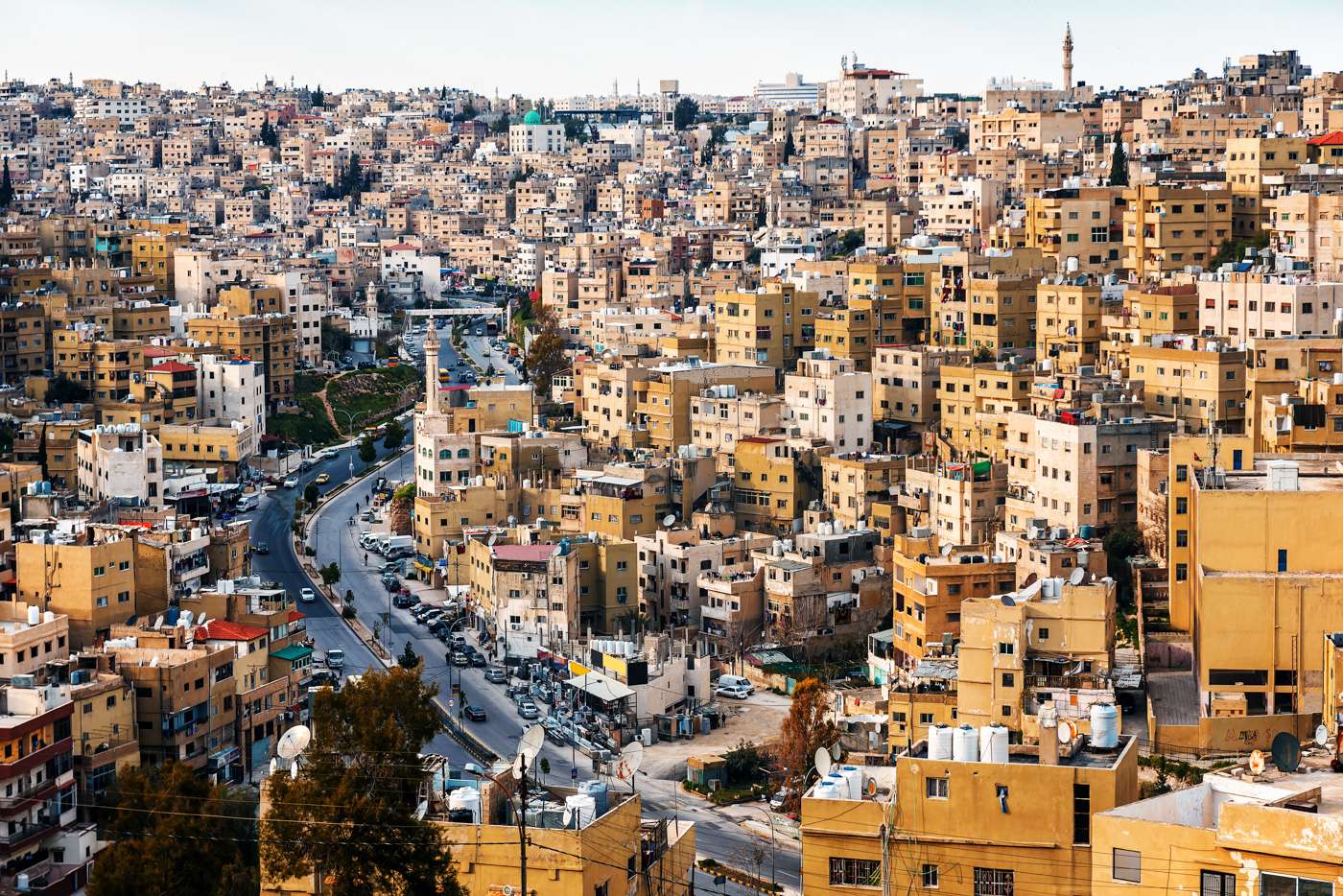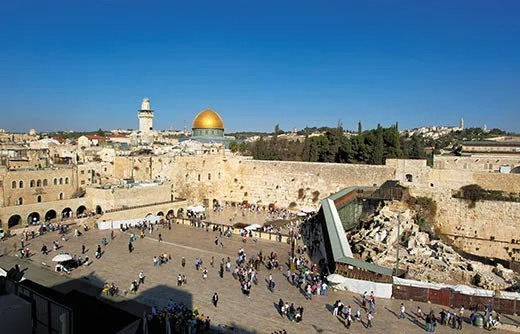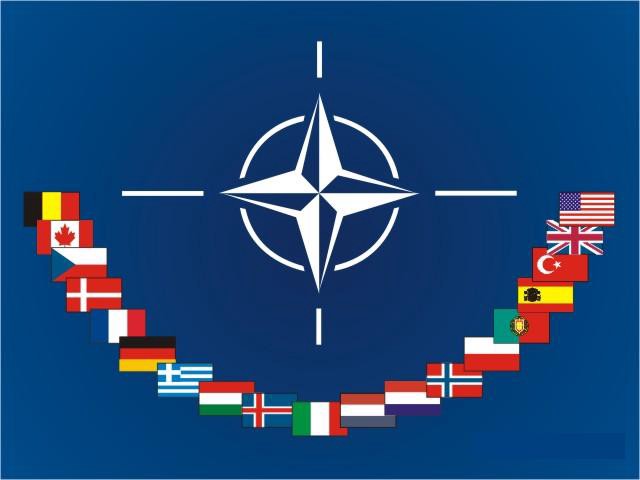By David Wurmser
Various senior intelligence sources in Israel over the last weeks have suggested in public that they assess the upheaval in Iran to be serious, perhaps even profoundly altering of Iran’s behavior, but in the end, that they “do not see that the regime is in danger.”2 This Israeli assessment follows weeks of private signaling from the United States that it also did not believe Iran’s regime would fall. That this was indeed the US assessment was publicly confirmed by CIA director William Burns during his with PBS’s Judy Woodruff. 3 Avril Haines, the Director of National Intelligence, added: “”We’re not seeing the regime perceive this as an imminent threat to their stability and effect,”4
The reasons for arriving at such pessimism on regime change that Israeli intelligence has given also parallels those filtering out of US governmental discussions as well: lack of centralized opposition leadership; lack of funds, and lack of internal regime defections. A revolution, they assert, needs those conditions to succeed. So it appears that Israel’s assessment reflects Israel’s increasing proclivity to defer to American judgments on the region.
Apart from the rather unusual nature of such public intelligence assessments, these statements by Israel and the US are demoralizing to Iranians, hand the Iranian regime an unnecessary boost of confidence and squander somewhat the potential for a post-Ayatollah Iranian-Israeli rapprochement.
So what are we to make of these statements? Are they even right?
Israel’s intelligence structures are storied, and deservedly so. Only the passage of time will allow for the full unveiling of what Israel’s shadow services have done to understand, follow and comprehend the full nature of the Iranian threat, as well as to sabotage it. Fleeting episodes of assassinations, mysterious work accidents, and occasional top-secret archival transplantations to Israel suggest the parameters, depth and professionalism of penetration of Iran which the Israeli security structure has managed. From personal experience, while it is still classified, suffice it to say in general that the understanding of Israel’s intelligence about Iran has surpassed that of any other country’s already two decades ago. Nobody else holds a candle to them. As such, it is with great deference and trepidation that one would dismiss their estimates.
And yet, on the case of Iran’s potential regime collapse, it would be wise not to accept the estimates of the intelligence community as the definitive word. Indeed, on this specific question, there is no reason to believe that either Israeli or US intelligence – from which Israel’s intelligence seems to have derived its assessment — has a particularly superior insight that justifies uncritical acceptance.
The advantage of an intelligence structure is its access both to vast information, some of which is invisible to the general public, as well as to governmental data management structures that allow for powerful substantive searches or even artificial intelligence assisted analyses. And yet, assessments on this level of perspective must by their nature be grounded first and foremost in a strong appreciation for the context of culture, ideas and exposure to broad swaths of society – all areas in which an intelligence structure has no particular advantage. When it comes to broader questions such as strategic interpretation and political trends, students of history (who rely on appreciating the patterns and character of culture), political theorists (who examine political systems over millennia), and those present on the ground (inhabitants, foreigners such as journalists) have as good a sense of the context and exposure to trends operate as an intelligence officer or expatriate. In other words, there is nothing more informed about an intelligence agency’s estimate about the potential for a revolution’s success than that of a good non-intelligence agency analyst or scholar.
It is not that US and Israeli intelligence assessments are entirely in agrrement with what the opposition appears to believe. Indeed, there appears to be a rough consensus on several points. First, Iran’s people are fed up with the regime. They are palpably seething in their anger and their disdain. And it is universal. Second, the regime clearly retains the will to kill – which was absent, for example, in the 1989 annus mirabilis of eastern Europe’s liberation. Third, there is increasing foreign intervention that helps the Iranian regime survive. Fourth, the population generally is disarmed facing a heavily armed gendarme. And fifth, the opposition is not operating at this point in a mirrored fashion – it does not match the regime’s a centralized authority, structure of well-funded instruments of attack and foreign material support.
But here the consensus between the US and the opposition, and even the US and Israel, seems to fray. The US also appears to believe that the threat of separatist violence will dampen popular support “to go all the way,” or in the very least will make nation-wide opposition coordination efforts difficult. This, of course, has been a theme pounded into the public debate by Iran’s disinformation networks and mouthpieces in the West. The US and Israeli governments also appear to disagree ultimately as to whether this unrest can lead to a more reformable and malleable government or not. While the US believes apparently that reform is still possible, in contrast Israeli officials and intelligence analysts fully agree with Iranians of all factions, who appear to summarily dismiss with certainty and even irritated impatience any hope of reform.
It is these insights — over only some of which intelligence services may have some particular unique sources of information – that the US and Israel conclude that the regime is threatened but will survive.
And yet, that is where the limits of intelligence analysis kicks in and provides an incomplete, and quite possibly inaccurate, picture.
Those with the most sensitized understanding of where things are headed are the people on the ground in Iran – the people braving arrest, running into bullets and facing possible assassination. Even a cursory survey of opposition communications over the last three months indicate a novel and quite adamant assertion that “this time it is different.” This sentiment was present in the week after Mahsa Amini died, and even more so now. Indeed, the Iranian opposition both in exile and in Iran acts with such confidence that they appear to believe it is a forgone conclusion that the regime is finished, is the walking dead, the corpse of which will soon be swept aside. The Iranian opposition universally just dismisses with impatience analyses that compare this upheaval to the several failed uprisings, including the most serious ones of 2009 and 2019.
The opposition’s confidence is matched by its actions. The regime, even Ayatollah Khamenei himself, has at several points ominously threatened and demanded the demonstrations stop immediately; no further “or else.” The strategy was to win by injecting fear and terror on top of the fragmented and separatist, atomized society. As Iranian scholar Damon Golriz has noted, the regime’s doctrine is called (النصر بالرعب Al-Nasr Bal Raeb) which means winning by terrorizing people into submission, The concept refers to three Surah Anfal (12), Surah Al-Imran (151), Surah Ahzab (26). Again, as with the separatist question, CIA director Burns admits that he has been rather surprised as well by the resolve of the Iranian people and assesses the “genuine courage” of Iranians. He also noted that his Israeli colleagues also believe that “the people of Iran have overcome the barrier of fear.”
Indeed, after the issuance of such ominous threats by the regime, the demonstrations generally escalated rather than faded and also led to further uprisings. The government then applied the “or else” – live ammunition, executions in public, horrific and systematic torture and unspeakable brutality on a vast scale. But this butchery failed to suppress. Rather, it only led to yet further upheaval and intertwining cycles of 40-days (the end of mourning periods in which vengeful violence often follows). In other words, the government has the will to kill, but the population appears to be little deterred by this and escalates in response. How does one deter a population over which one has lost the asset of fear?
Moreover, the separatist demon which seems to be so central to shunting the analysis of Western intelligence onto the sidetrack of pessimism, but the reality on the ground suggests that the regime’s propaganda has captured Western elites, but not Iranians. Indeed, it appears to those on the ground almost entirely the opposite.
In his interview, while at the same time Western elites bemoan the lack of a unified leadership as an insurmountable barrier to success this round and constantly raise the separatist specter that emerges from this, even CIA director Burns was forced to admit, and even underscore that he is quite surprised by the unprecedented “duration” and “scope” of these protests and that they are “cutting across” Iranian society. In other words, the totalitarian regime’s attempt to atomize society into conflicting entities (e.g. men vs. women, nation vs. diaspora, Shia vs. Sunni, Kurd or Arab vs. Persian etc.) has failed, and it is thus losing its grip in executing the divide-and-rule strategy.
The extent to which regions are expressing solidarity with one another across ethnicities and sects, and the disciplined unified messaging of all opposition forces is stunning – despite hellbent efforts by the regime and its western apologists to incite divisions among them. There is even a unified language of symbolism in resistance of victims (Mahsa Amini, Nika Shukarami…), songs (Baraye) and slogans (Zan, Zendegi, Azadeh—Woman, Life Freedom). All factions of the opposition appear determined to focus on regime collapse as the highest common priority and regard the failure to achieve that as the single greatest obstacle to achieving any other goal they might hold.
As far as the funding question goes, there is a balancing beginning not because the opposition is getting money, but because the regime is losing it. The spread of strikes and paralyzed economic activity from general unrest is clearly beginning to stress the regime. Critical industries are either fully struck or struck in rolling temporary outages – from oil workers to bazaar merchants. There are signs this hurts: foreign disbursements of money have declined to regional terror groups, such as the Palestinians. Indeed, The Plan and Budget Organization of the Islamic Republic announced in an analytical report, a year ago (summer of 2021) already then concluded that if the “unhealthy economic structure of the country” were not fundamentally revised, the Iranian government will be on the verge of bankruptcy by 2024 and three years after that, it will go bankrupt in 2027.”5
A concerted campaign of tightened sanctions coupled with the widespread climate of strikes could easily snowball if Western governments launch a determined effort. One could only imagine what might happen if foreign governments placed all of Iran’s frozen assets into the hands of the Iranian opposition.
Taken together, there seems to be a momentum and intensity to the upheaval that has not abated, which to some extent even US and Israeli intelligence do seem to acknowledge. But these intelligence agencies at the same time seem to admit that they are somewhat surprised by this resilience, and did not appreciate – and apparently still do not – appreciate from where it is coming from other than sheer despair.
Even though US and Israeli intelligence officials admit that there appears to be universal upheaval by all segments of Iranian society, and even they also admit that Iranians are showing incomprehensible bravery in charging regime forces and sustaining the revolt, the assessment of both Israeli and American intelligence communities remains; the regime is not facing an “immediate threat” to its survival, because ultimately they believe the regime’s strategy of repression is effective, and that it has not exhausted its tools of repression and brutality. In the Israeli intelligence estimate:
“The deep change Iran is undergoing will not necessarily result in a revolution and regime change. Right now, we do not see this happening in the foreseeable future …The regime still has many tools with which to defend itself and it has not exhausted most of them.”6
In other words, though separatism, lack of funding and fear have not yet stopped the freedom revolution, they eventually will. Despair cannot ultimately overpower fear – which will set in — and lead (bullets) – which the regime has.
And yet, revolutions do not automatically happen just because there is widespread despair. Nor is the correlation of forces determinant as the historical record of revolutions suggest. Clearly something else is at work which US and Israeli intelligence structures are not grasping. But what is this intangible factor that seems to be at work here that drives the opposition’s confidence with such determination, but is entirely missed by the professional analysts of Western governments? Why are those taking to the streets so confident that not only has fear notworked for the regime, but it will it not work going forward either?
Reading between the lines, the opposition appears to believe that a Jinn (Genie in Western parlance) has been released from his bottle, and that he cannot be shoved back into his vessel by the regime. Only by indentifying this “Jinn” can one properly understand why there is such resolve and confidence among Iran’s youth who take to the streets.
Ironically, this “Jinn” comes from the regime itself. The very attribute that gives the regime the will to kill – its obsession with martyrdom raised to the level of being a cult of death – has been so broadly seared through all-encompassing indoctrination of children and adults alike over several generations that it now is bending back to haunt the regime.
It is apparent that parents in Iran are tired. They are not the agents of this revolution right now. They love and lost too many children, and with every death, there is deep mourning at the funeral. The image that raced across the social media on December 8 when the family of Mohsen Shekari was informed of his being hanged – with screaming out of sheer agony on the street – is heartbreaking, haunting and entirely comprehensible. The parents are too worn down to sacrifice yet another generation of children to the cult of death. But that parents are not the ones leading the emerging revolution; they are broken generations. But the youth are not.
And this revolution belongs to Iran’s youth.
Youth are often more absorbent of the world around them and impervious to danger, and the constant atmosphere of worshipping martyrdom has created a generation that at this young age sees the pursuit of an idea as worthy enough for which to die. The idea for the Ayatollahs for which they hoped all would welcome death to realize was the archaic glorious expansion of a totalitarian form of Islam. But for the youth, such a vision of Islam has no appeal. Indeed, it is a violation of the ancient understanding, so the deal struck in 654 AD is now off. The idea of freedom – perhaps not fully formed, but very real – has replaced it.
In this climate of constant martyrdom, the phrase “give me liberty or give me death,” which is so familiar but practically has become distant to young Americans has for Iran’s youth acquired a whole new imagery translated locally. “Zan, Zendegi, Azadeh” has become the cultural equivalent of Patrick Henry’s “Give me liberty or give me death.” It is one of those rare moments where the few words of a slogan capture, rather than infantilize, vast volumes of ideas and communicates them across all the people of that culture via a universally understood code.
So ironically, the very animus propelling the regime to kill and rampage regionally – the obsession with death emerging from a cult of martyrdom – now drives Iran’s youth in seething disdain to risk everything in revolt. Every time the regime shoots and kills, and every day there is another execution, it not only fails to deter, but the very cult of martyrdom it cultivated now swells to haunt and plague it. With fear compromised, the central currency of terror upon which the regime relies is lost.
This distortion is a tailwind driving the revolution to probable success – the regime lacks the means to erase the willingness to die that challenges them — but it is also a blight with which the post-Ayatollah regime will have to wrestle. The ancient soul of Iran is of light and life, not darkness and death. The world of Iran’s civilizational creation – the deepest reach of Iran’s soul to this day – is the world which Abolqasem Ferdowsi described and embodied in his works. As Azar Nafisi wrote, quoting her father, in the introduction to a recent translation of Ferdowsi’s Shahnameh: the Persian Book of Kings, in the kingdom of imagination Ferdowsi built
“Rostam, Tahmineh, Seyavash, Bizhan and the other fictional characters … became our brothers and sisters, cousins and neighbors…For Persians, Shahnameh is like their identity papers … Against the barbarity of time and politics, … they created magnificent monuments in words, they reasserted both their own worth and the best achievements of mankind through a work like Shahnameh, the golden thread that links one Persian to the other, connecting the past to the present.”7
Simply, the soul of Iran is reflected in poetry. The idea of poetry as a vehicle of transmitting identity distant from how Americans understand ourselves, especially our youth. But poetry and songs of Iran, like e-Iran, and terms, like “Iranzamin” capture the deep and unique civilizational emotion that touches Iran’s soul and anchors them to their land – namely something akin to Abraham Lincoln’s “mystic bonds of memory.”
Shahnameh describes not a conquest and religious conversion of ancient Persia, but a cultural rapture between very different, and indeed diametric opposite, cultures. The refined, urban and wealthy Persia was overtaken by the harsh, stark, simple and nomadic conquerers – Indeed, Ferdowsi —in a warning to the wealthy, urban and technologically superior West across a millennia and half — laments the juxtaposition in this spectacle between the gilded armor and shining military display of the Persian armies which may have looked impressive externally but whose internal will broke so easily from the rust of comfort and then surrendered to the much less armed, much less wealthy and much less clad Arab invaders.
And yet, the symbolism of this ancient culture offers a pillar of resurrection. The poplar tree bends in the wind, the origin of the symbol of our “paisley” was a Victorian era fascination with motifs of the orient, so it has been vastly popularized in clothing, carpets, ties and paintings throughout the world. But this is no more art work for the Persians: it is an allegory of their culture and the moment of surrender that Ferdowsi describes. The poplar tree, signifying ancient Iranian culture, lasts forever, but it has to bend to the wind, signifying Islam, to do so.
Inflexible resistance would have only led to its breaking and erasure. For the Muslim invaders, this was fine. Although it conceded some to ancient Persia to allow some elements of its culture and its cultural memory to survive, it gained as well since attempting to control this ancient culture was preferable to the business of erasing it altogether. The Arab invaders lacked the numbers to extinguish Persia in all its complexity, vastness and influence, so the deal that has lasted over a millennium was struck.
Ancient Persian culture, thus, still has a grip on some corner of the Iranian soul, but it has been bent and covered by the greater forces of Islam for millennia.
So over the soul of light and life, a culture that so worships fire and light, is an overlay that has been imposed. While various forms of Islam, and various phases of Islamic evolution, upheld the ancient deal, this new form of Islam, developed over the last century and imposed on Iran in 1979, has violated the millennium-long understanding with its Persian hosts.
The totalitarian intrusion into Shiite thought, anchored onto the idea of the Valayat e-Faqeh (Rule of the Jurisprudent) over the last decades has sought to erase the last remnants of Persia, and it is finding that this ambition is likely no easier to have accomplished now than it was in 654 AD. Ironically, while the government of the Ayatollahs tries to spin its new ideology as some deep, culminating expression of Iranian culture, the truth is more likely the opposite. A reasonable argument can even be made that this newest, modern form of totalitarian Islam is the triumph of a Greek philosophical Shibbolet – namely Plato’s idea of the “philosopher king” which is now invested with a religious fervor and pious veneer against which Aristotle argued — over the Persia represented by Cyrus.
This twisted manifestation of Islam is a world of darkness and death, embodied by the dour, cruel and arrogantly detached leadership of these reigning Ayatollahs. It is undeniable that at the heart of all Shiism is the ongoing pain and reliving of the assassination of Ali in 661 AD, and the following martyrdom of his sons Hasan in 670 AD and Husayn a decade later in Karbala, but this regime of Iran has taken this reverence for their martyrdom and raised it to the single, defining factor of its existence. Theirs is the God of misery, where life is easily bartered for the relief of death, where the hell of earth is traded for the paradise of the afterlife. The value of emulation is taken to the extreme to striving to reach the demise that the founding three suffered.
This grim, bleak desolation offered by the regime offers little for which to live, while at the same time its diminishing of the value of life instilled over generations also erases the fear upon which the regime depends for survival. This duality is the Jinn the intelligence communities miss, but which the Iranian people appear to believe has been released from its vessel.
Something profound is gripping Iran. A twilight struggle to the death has been joined. The Ayatollahs have violated the old understanding between Persia and Islam. The intensity of the ensuing suppression and the acceleration of their attempts to erase the Persian heart of the nation have now cut so deep that it has forced Iranians, as the trustees of their ancient culture and legacy, who breathe the poetry and stories of their history to nurture their unique soul, into a battle for survival. And yet, now as then, the forces of totalitarianism attempting to extinguish Persia simply lack the numbers. And they will thus eventually lose.
And this is the point that both Israeli and American intelligence agencies appear to miss entirely. It is not their fault. Intelligence operates in a world of stress and short fuses. They are navigators to a captain in a storm. The captain cannot suffer a long treatise on fluid dynamics from a navigator; he needs an immediate judgment as to what he should do. Yes, they should appreciate context, but immediacy and urgency does not lend itself well to the contemplation of long-term trends. And yet, in such a moment as Iran finds itself, it is only those long-term trends that illuminate for us where affairs are headed. Intelligence assessments are occasionally the consequence of such careful reflection, but usually, they are of limited value.
As a final thought, sadly, this cult of death imposed by these totalitarians will bedevil Iran after liberation as well. It has left its scars, and scars are never easily covered, let alone erased. One can only hope that an effort to reawaken the contrasting, ancient soul of Iran — whose passing Ferdowsi documents, memorializes but also embodies — in order to create a relish for life and light to overpower this cult of death will prevail. Indeed, this effort to erase this tormenting distortion of the soul is going to be the most important but difficult task of the post-Ayatollah Iranian leadership.
